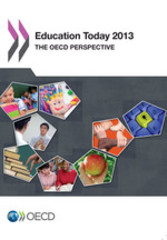
Education Today 2013: The OECD Perspective

von: OECD
OECD Paris, 2013
ISBN: 9789264186811
Sprache: Englisch
132 Seiten, Download: 3659 KB
Format: PDF, auch als Online-Lesen
| Foreword | 5 | ||
| Table of Contents | 7 | ||
| Note on Country Coverage and Levels of Education | 11 | ||
| Executive Summary | 13 | ||
| Introduction | 17 | ||
| Chapter 1 - Early Childhood Education and Care | 19 | ||
| Introduction | 20 | ||
| Key findings | 20 | ||
| Figure 1.1. Enrolment rates at age four in early childhood and primary education (2005 and 2010) | 21 | ||
| Figure 1.2. Expenditure on early childhood education institutions as a percentage of GDP (2009) | 22 | ||
| Figure 1.3. Ratio of children to teaching sta in early childhood education (2010) | 23 | ||
| Policy directions | 24 | ||
| References and Further Reading | 27 | ||
| Chapter 2 - Schooling: Investments, Organisation and Learners | 29 | ||
| Introduction | 30 | ||
| Key findings | 30 | ||
| Figure 2.1. Relative expenditure per student by educational institutions for all services at different levels of education (2009) | 31 | ||
| Figure 2.2. Average class size in primary and secondary education (2010) | 32 | ||
| Figure 2.3. Proportion of class time spent teaching and learning, by new and experienced teachers (2008) | 35 | ||
| Figure 2.4. Total number of intended instruction hours in public institutions between the ages of 7 and 14 (2010) | 37 | ||
| Policy directions | 40 | ||
| References and Further Reading | 44 | ||
| Chapter 3 - Transitions Beyond Initial Education | 45 | ||
| Introduction | 46 | ||
| Key findings | 46 | ||
| Figure 3.1. Population that has attained upper secondary education (2010) | 47 | ||
| Figure 3.2. Percentage of 15-19 year-olds not in education and unemployed or not in the labour force (2010) | 50 | ||
| Box 3.1. Education and economic crisis | 51 | ||
| Policy directions | 53 | ||
| References and Further Reading | 58 | ||
| Chapter 4 - Higher Education | 59 | ||
| Introduction | 60 | ||
| Key findings | 60 | ||
| Figure 4.1. Younger and older working-age adults having attained tertiary education (2010) | 61 | ||
| Figure 4.2. Proportion of boys and girls planning a career in engineering or computing (2010) | 62 | ||
| Figure 4.3. Distribution of foreign students in tertiary education, by country of destination (2010) | 65 | ||
| Policy directions | 67 | ||
| References and Further Reading | 72 | ||
| Chapter 5 - Lifelong Learning and Adults | 73 | ||
| Introduction | 74 | ||
| Key findings | 74 | ||
| Figure 5.1. Participation in non-formal education, by age group (2007) | 75 | ||
| Box 5.1. Participation in adult learning for 65-74 year-olds | 78 | ||
| Policy directions | 79 | ||
| References and Further Reading | 82 | ||
| Chapter 6 - Outcomes, Benefits and Returns | 83 | ||
| Introduction | 84 | ||
| Key findings | 84 | ||
| Figure 6.1. How pro cient are students in reading? (2009) | 85 | ||
| Figure 6.2. How pro cient are students in digital reading? (2009) | 86 | ||
| Figure 6.3. Relative earnings from employment among 25-64 year-olds, by level of educational attainment and gender (2010) | 90 | ||
| Box 6.1. Education and life expectancy | 94 | ||
| Policy directions | 95 | ||
| References and Further Reading | 99 | ||
| Chapter 7 - Equity and Equality of Opportunity | 101 | ||
| Introduction | 102 | ||
| Key findings | 102 | ||
| Figure 7.1. Prevalence of rst- and second-generation immigrant students (2009) | 105 | ||
| Figure 7.2. Gender di erences in reading performance in PISA (2009) | 106 | ||
| Figure 7.3. Participation in higher education of students whose parents have low levels of education (2009) | 108 | ||
| Policy directions | 110 | ||
| References and Further Reading | 115 | ||
| Chapter 8 - Innovation and Knowledge Management | 117 | ||
| Introduction | 118 | ||
| Key findings | 118 | ||
| Figure 8.1.Annual expenditure on R&D per tertiary student in OECD countries (2009) | 120 | ||
| Box 8.1. Innovative educational technologies | 121 | ||
| Policy directions | 123 | ||
| References and Further Reading | 127 | ||
| More information on OECD’s work on education | 129 |







